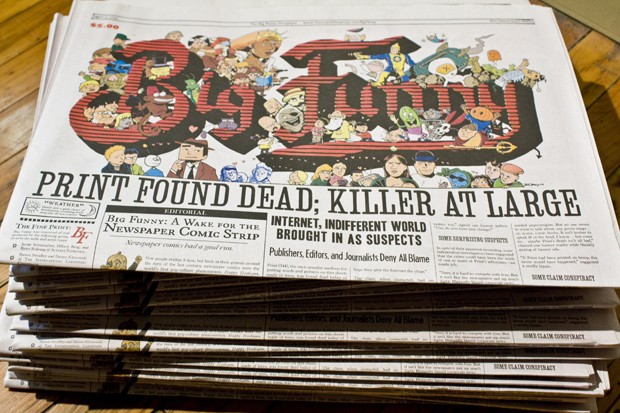WHAT: Big Funny WHEN: Until Aug. 29 WHERE: Altered Esthetics, 1224 Quincy St. N.E. ISSUES: $5 For true lovers of comics, the idea a newspaper comprised of nothing but comics is almost as exciting as a cupcake shop that sells nothing but frosting. But occasionally fantasy becomes reality and manifests itself in the form of projects like âÄúBig Funny,âÄù a coffee table paper of original comics that pays heed to the glory days of newspaper comics. âÄúBig FunnyâÄù is a collaboration between illustrator hub The International Cartoonist Conspiracy, Big Time Attic studio and Altered Esthetics gallery, where it premiered last week as part of a larger exhibition. âÄúA long time ago, the comic strip started shrinking, two to a page, and then three and then four, and these days itâÄôs not unusual to find eight crammed onto a funny page. ThereâÄôs no room for a cartoonist to make a graphic dynamic statement,âÄù explains Terry Beatty , contributor, artist and teacher in the comics program at Minneapolis College of Art and Design. Editor of the paper and organizer of the event Steven Stwalley agrees. âÄúModern news comics seem myopic in what they think that they can do,âÄù Swalley said. âÄúThey focus on the same kinds of themes, the same jokes.âÄù âÄúBig FunnyâÄù sought to bring back the range of creativity that early 20th century newspapers gave to comics, allowing each one to spread their artistic vision over an entire page, if they so choose. The result is 48 pages of both color and black-and-white comics, packed with stenciled fonts, cross-hatched characterizations and plenty of jokes about everything from reproduction to politics. But not every contributor decided to use up the entire page. On the front page, an anonymous source drew a tiny âÄúchoose your own adventureâÄù strip along the bottom of the text. Not to give out spoilers, but one panel leads to getting goat testicle implants. Another of the most interesting comics is âÄúLittle Emo in Slumbaland,âÄù by Jesse Gillespie . With eye-catching washes of color and a wonky set of characters, it tells the tale of Little Emo, who is too âÄúunlethargicâÄù to return to Slumbaland with King BombastikâÄôs loyal imp. The topic of âÄúemo-nessâÄù may seem ultra-modern, but GillespieâÄôs strip is actually a tribute to âÄúLittle Nemo in Slumberland âÄù from early last century. âÄúThe art and writing style is very unoriginal, totally ripping off that old comic,âÄù Gillespie explains, although the hip-hop themes imply an original touch of pop-culture reference. While the paper is a stimulating read, itâÄôs also worthwhile to visit the gallery. Seeing comics in their original form allows for the small details of production to show through âÄî the pencil lines, the tracing paper, the thickness of the ink or paint used. All of the comics appear flat and smoothly produced in the paper version, but up close many of them are composed of layers of paper that expose an artistry that separates the craft from the printing press feeling of newspapers. Plus, only at the gallery can you find vintage newspapers and an old cigarette machine that vends copies of âÄúLittle Funny,âÄù mini comics stuck in cigarette boxes. When asked if âÄúBig FunnyâÄù will morph into a recurring publication, the creators were hopeful. Funded primarily by in-house advertising that gives local establishments a chance to display their message in comic form, the business model leaves room for a second go. Editor and curator Kevin Cannon (Big Time Attic) has been asked frequently when âÄúBig Funny 2âÄù is going to come out. It appears as if both artists and readers are interested in the possibility. Maybe the creators have found a way to send comics on a lifeboat away from the sinking ship that is the newspaper industry. With an increase in comic-to-film projects (âÄúWatchmen ,âÄù âÄúBatman, âÄù âÄúThe Spirit âÄù), the momentum of the medium is only growing. As Beatty puts it, âÄúComic books are the red-headed stepchild of newspaper. TheyâÄôre a unique thing, but the public loves them.âÄù

Image by Ashley Goetz
‘Big Funny’ puts the comic in the spotlight
The release of a 48-page newspaper made entirely of comics is a lifeboat for a medium stuck in the sinking newspaper industry.
Published August 11, 2009
0
More to Discover







